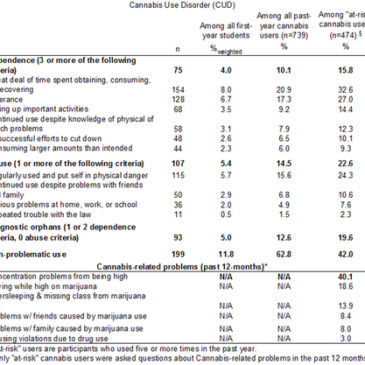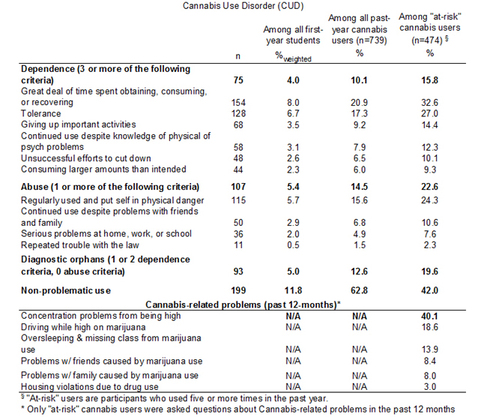Despite the illegality of cannabis in the United States, between 30 and 40 percent of college students report having used cannabis during the past year (Eaton et al., 2006; Johnston, O’Malley, Bachman, & Schulenberg, 2007; Mohler-Kuo, Lee, & Wechsler, 2003). There is little evidence about the prevalence of Cannabis Use Disorder (American Psychiatric Association, 1994) among college students. This week’s STASH examines research conducted by Caldeira, Arria, O’Grady, Vincent, & Wish (2008) examining rates of Cannabis Use Disorder and cannabis-related problems among first-year college students.
Researchers administered a brief survey to 3,401 incoming first-year students (89% of the freshman class) at a large public university in the U.S. mid-Atlantic region. Using a purposive sampling strategy 1, researchers over-sampled experienced drug users and selected 1,457 students to participate in a longitudinal study beginning with a two-hour face-to-face interview 2. Researchers collected responses for 1,253 students in the longitudinal cohort (86%). Students answered questions about their illicit drug use (e.g. lifetime, past-year, and past month), problems related to drug use, and past-month use of alcohol and tobacco.
Figure. Cannabis Use Disorder and other problems among first year college students and past year cannabis users (adapted from Caldeira et al. 08). Click image to enlarge.
Table 1 shows the results for three groups: weighted prevalence estimates for the entire first-year class, past-year cannabis users, and “at-risk” cannabis users (i.e., students who used cannabis at least five times in the last calendar year). Among all past-year cannabis users (N = 739), approximately 25% of students met the criteria for Cannabis Use Disorder. Ten percent (10.1%) met the criteria for dependence by endorsing three or more of the six DSM-IV dependence criteria, and 14.5% met the criteria for abuse by not qualifying for a dependence diagnosis and endorsing one or more of the abuse criteria. Sixty four percent (64.1%) of cannabis users consumed cannabis five or more times in the past year. Among students who used cannabis five or more times in the past-year the most common problems associated with past 12-month cannabis use were: concentration problems 40.1%, driving a car while high 18.6%, and oversleeping and missing class 13.9%.
Several factors limit the study findings. The research data is based on self-report and subject to the inaccuracies associated with that data source. The researchers did not measure Cannabis Use Disorder among students who used less than 5 times in the past 12-months. Instead, researchers automatically coded them for the absence of the DSM-IV criteria for Cannabis Use Disorder. In addition, researchers only asked “at-risk” students about cannabis-related problems. Students who used cannabis 4 or fewer times might have experienced some cannabis related problems. The survey instrument only had six questions about Cannabis-related problems. It is possible that individuals experienced problems not addressed in the survey. Leading to an under reporting of the number of students that experienced cannabis-related problems.
The study’s findings, weighted to represent the entire first-year class, indicate that 17% of the class used cannabis in the past year without problems, and 9% satisfied the DSM-IV criteria for abuse or dependence. Among past-year cannabis users, 75%, of the students did so without experiencing the DSM-IV criteria for abuse. This might be an over estimation because students who used cannabis four or fewer times, representing 36% of cannabis users, in the past year were not asked the DSM-IV Cannabis Use Disorder criteria. Although the majority of students report controlled cannabis use, some of these students did incur problems related to their use. The question the researchers did not ask was: why were 75% of students able to use cannabis in a controlled manner, while 25% were not? A long-term follow-up is needed in the area of Cannabis Use Disorder to determine if the results presented here are typical of college students. Substance use researchers also might consider examining the potential factors that allow most cannabis using students to do so in a controlled fashion, while others are not able to.
What do you think? Please use the comment link below to provide feedback on this article.
________________
[1] A procedure in which researchers over sample strata of interest.
[2] The research presented in this review is part of the College Life Study, a five-year prospective study under the supervision of Amelia Arria at the Center for Substance Abuse Research (CESAR), the University of Maryland. The BASIS will continue to follow and report study findings as they become available through peer-reviewed journals.
References
American Psychiatric Association. (1994). DSM-IV: Diagnostic and statistical manual of mental disorders (Fourth ed.). Washington, D.C.: American Psychiatric Association.
Caldeira, K. M., Arria, A. M., O’Grady, K. E., Vincent, K. B., & Wish, E. D. (2008). The occurrence of cannabis use disorders and other cannabis-related problems among first-year college students. Addictive Behaviors, 33, 397 – 411.
Eaton, D. K., Kann, L., Kinchen, S., Ross, J., Hawkins, J., Harris, W. A., et al. (2006). Youth risk behavior surveillance–United States, 2005. MMWR Surveill Summ, 55(5), 1-108.
Johnston, L. D., O’Malley, P. M., Bachman, J. G., & Schulenberg, J. E. (2007). Monitoring the Future national survey results on drug use: Volume II, college students and adults ages 19 – 45 (NIH Publication No. 07-6206). Retrieved 2/11/08. from http://www.eric.ed.gov/ERICWebPortal/custom/portlets/recordDetails/detailmini.jsp?_nfpb=true&_&ERICExtSearch_SearchValue_0=ED498426&ERICExtSearch_SearchType_0=no&accno=ED498426.
Mohler-Kuo, M., Lee, J. E., & Wechsler, H. (2003). Trends in marijuana and other illicit drug use among college students: results from 4 Harvard School of Public Health College Alcohol Study surveys: 1993-2001. Journal of American College Health, 52(1), 17-24.





